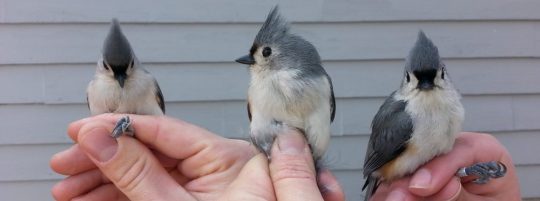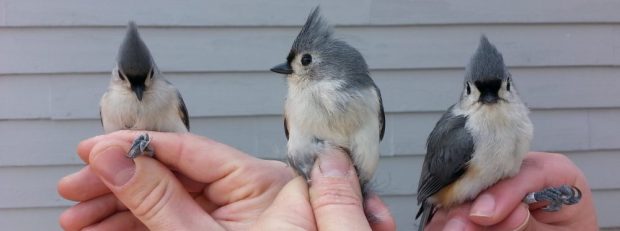
I studied biology in university, and it’s always nice to find places that let me keep my skills sharp and pick up some new knowledge. My partner and I recently started volunteering at the Ruthven National Historic Site just outside the center of Cayuga, and they have the nicest birding lab I have ever seen! The Ruthven Park bird observatory processes hundreds of birds every season, and they welcome volunteers of all backgrounds because they really do believe that anyone can be a birder if they practice enough. Nancy and Rick are the banders in charge, and they’ve created such a wonderfully welcoming place that I think the Ruthven Park Bird Observatory would make a great place to volunteer if you’re interested in nature.
Bird Banding
At the Ruthven Park Bird Observatory, birds that are caught in nets or traps (they don’t get hurt!) are taken into the observatory to be banded. Bands are just numbered metal bands that the bird carries on it’s foot, so that if it’s ever caught again, the number on the band can tell handlers where the bird was and how it was doing at the time. To band birds you’ve got to go through all sorts of things, starting ID’ing it, aging it, figuring out if it is male or female, how long its wings are, and how much fat and muscle is on it. It sounds really tricky, but my partner and I learned how to do it in a day and I’m sure non-biologists could too!
Census Counts
For an hour every day, staff at the Ruthven Park Bird Observatory go out and walk on a set route around the property to identify as many birds as they see or hear. This is important to have a biodiversity record of the species in the area. The other day, we saw an osprey, meaning that its got some decent food sources in the area. Going on census counts is very helpful in developing field skills, and my partner enjoys this part most of all.
Education
Lots of school groups visit the Ruthven Park Bird Observatory throughout the season, and the banders love hosting them. Have you ever seen a blue jay play dead? Most kids haven’t either, but staff at the observatory can show you their sneaky trick! Bigger birds don’t know what to do when they’re on their backs, so they just lie there until you flip them over and release them! Educating people on the importance of conservation and these banding projects is so important, and if you like outreach activities, this is always something you can do.







No Comments